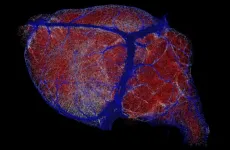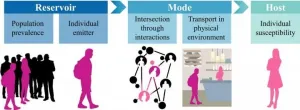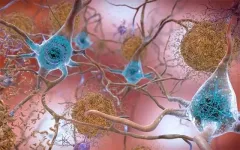Layperson can reduce pregnant women's depression as well as mental health professional
Trained paraprofessionals deliver CBT to women and expand care
2021-03-03
(Press-News.org) Home health visits change to virtual ones during pandemic
'We don't have to rely on mental health professionals'
As perinatal depression soars during pandemic, there's a growing need for treatment
CHICAGO --- Perinatal depression has soared during the pandemic. But many mental health professionals are overwhelmed and can't take on new clients.
Good news comes from a new Northwestern Medicine study finding paraprofessionals generated similar reductions in depressive symptoms as mental health professionals when delivering a group-based cognitive-behavioral therapy intervention.
The study findings are based on adding home health visits by trained lay health professionals to low-income pregnant women in a national project called Mothers & Babies. Mothers and Babies is an intervention using cognitive behavioral therapy that aims to reduce stress and improve mood among pregnant women and new mothers.
But since in-person home-visits are no longer possible during the pandemic, the program has recently pivoted to deliver the therapy virtually to pregnant women.
"The response to Mothers and Babies delivered virtually has been incredibly positive from providers and clients," said lead study author Darius Tandon, associate professor of medical social sciences at Northwestern University Feinberg School of Medicine. "In this COVID environment, the need for mental health services is so great that providers and perinatal women who have stress in their lives are really valuing the ability to receive help remotely."
One in five women will develop postpartum depression, and both mother and child are adversely affected by postpartum depression.
"Preventing postpartum depression before it starts is critical in promoting the health and well-being of new mothers and their children," Tandon said.
"With appropriate training and supervision, lay health workers can do a good job," Tandon noted. "We don't have to rely on mental health professionals. We can go another route."
The paper will be published March 3 in Archives of Women's Mental Health.
This is the first study to the researchers' knowledge that has used lay home visitors to deliver a postpartum depression preventive intervention. Previous studies using lay health workers have focused on postpartum depression treatment.
Researchers say there is a growing interest in the notion of "task shifting", or moving care from more specialized (e.g., mental health professionals) to less specialized health workers.
"This study suggests that it is possible to 'task shift' the delivery of interventions aimed at preventing postpartum depression to paraprofessional home visitors, said Tandon, who is also co-director of the Center for Community Health at Feinberg. "This is notable given the lack of available mental health professionals in many communities, as well as stigma associated with seeing 'formal' mental health providers."
The use of paraprofessional home visitors - rather than costlier mental health professionals -- also may minimize cost associated with delivering interventions, he noted.
INFORMATION:
Other Northwestern authors on the paper are Jessica Johnson, Alicia Diebold, Melissa Segovia, Jackie Gollan, Aria Degillio, Dana Zakieh, Chen Yeh, Jesus Solano-Martinez and Jody Ciolino.
This project was funded by the Patient-Centered Outcomes Research Institute grant AD-1507-31473.
ELSE PRESS RELEASES FROM THIS DATE:
2021-03-03
New research has revealed that the diets of early lizards and snakes, which lived alongside dinosaurs around 100 million years ago, were more varied and advanced than previously thought.
The study, led by the University of Bristol and published in Royal Society Open Science, showed lizards, snakes, and mosasaurs in the Cretaceous period already had the full spectrum of diet types, including flesh-eating and plant-based, which they have today.
There are currently some 10,000 species of lizards and snakes, known collectively as squamates. It was originally understood their great diversity was acquired only after the extinction ...
2021-03-03
Patients with type 2 diabetes that were treated with a weekly injection of the breakthrough drug Semaglutide were able to achieve an average weight loss of nearly 10kg, according to a new study published in The Lancet today.
Led by Melanie Davies, Professor of Diabetes Medicine at the University of Leicester and the Co-Director of the Leicester Diabetes Centre, the study showed that two thirds of patients with type 2 diabetes that were treated with weekly injections of a 2.4mg dose of Semaglutide were able to lose at least 5% of their body weight and achieved significant improvement in blood glucose control.
More than a quarter of patients were able to ...
2021-03-03
Pregnant patients in Colorado may be told about parenting and adoption, but not abortion. This is according to a new study led by Kate Coleman-Minahan of the University of Colorado College of Nursing published in the END ...
2021-03-02
Our brains are non-stop consumers. A labyrinth of blood vessels, stacked end-to-end comparable in length to the distance from San Diego to Berkeley, ensures a continuous flow of oxygen and sugar to keep our brains functioning at peak levels.
But how does this intricate system ensure that more active parts of the brain receive enough nourishment versus less demanding areas? That's a century-old problem in neuroscience that scientists at the University of California San Diego have helped answer in a newly published study.
Studying the brains of mice, a team of researchers led by Xiang Ji, David Kleinfeld and their colleagues has deciphered the question of brain energy consumption and blood vessel density through newly developed maps that detail ...
2021-03-02
When you think about your carbon footprint, what comes to mind? Driving and flying, probably. Perhaps home energy consumption or those daily Amazon deliveries. But what about watching Netflix or having Zoom meetings? Ever thought about the carbon footprint of the silicon chips inside your phone, smartwatch or the countless other devices inside your home?
Every aspect of modern computing, from the smallest chip to the largest data center comes with a carbon price tag. For the better part of a century, the tech industry and the field of computation ...
2021-03-02
Imagine you're driving up a hill toward a traffic light. The light is still green so you're tempted to accelerate to make it through the intersection before the light changes. Then, a device in your car receives a signal from the controller mounted on the intersection alerting you that the light will change in two seconds -- clearly not enough time to beat the light. You take your foot off the gas pedal and decelerate, saving on fuel. You feel safer, too, knowing you didn't run a red light and potentially cause a collision in the intersection.
Connected and automated vehicles, which can interact vehicle to vehicle (V2V) and between vehicles and roadway ...
2021-03-02
Type 2 diabetes, once considered an adult disease, is increasingly causing health complications among American youth. A research review published in the Journal of Osteopathic Medicine suggests physicians should work to more aggressively prevent pediatric diabetes.
Because few pediatric Type 2 diabetes treatment options are available, prevention is unusually important. To improve health outcomes, the paper's authors recommend physicians conduct regular screenings of children and adolescents, adopt a high level of suspicion, and intervene early and often with families who have children at risk for prediabetes and T2 diabetes.
"Pediatric type 2 diabetes is more progressive and aggressive than adult-onset Type 2 diabetes," ...
2021-03-02
Boulder, Colo., USA: Several articles were published online ahead of print
for GSA Bulletin in February. Topics include earthquake cycles in
southern Cascadia, fault dynamics in the Gulf of Mexico, debris flow after
wildfires, the assembly of Rodinia, and the case for no ring fracture in
Mono basin.
Jurassic evolution of the Qaidam Basin in western China: Constrained by
stratigraphic
succession, detrital zircon U-Pb geochronology and Hf isotope analysis
Tao Qian; Zongxiu Wang; Yu Wang; Shaofeng Liu; Wanli Gao ...
Abstract:
The formation and evolution of an intracontinental basin triggered via the
subduction or collision of plates at continental margins can record
intracontinental tectonic processes. As a typical ...
2021-03-02
In the 1995 movie "Outbreak," Dustin Hoffman's character realizes, with appropriately dramatic horror, that an infectious virus is "airborne" because it's found to be spreading through hospital vents.
The issue of whether our real-life pandemic virus, SARS-CoV-2, is "airborne" is predictably more complex. The current body of evidence suggests that COVID-19 primarily spreads through respiratory droplets - the small, liquid particles you sneeze or cough, that travel some distance, and fall to the floor. But consensus is mounting that, under the right circumstances, smaller floating particles called aerosols can carry the virus over longer distances and remain ...
2021-03-02
Amyloid plaques are pathological hallmarks of Alzheimer's disease (AD) -- clumps of misfolded proteins that accumulate in the brain, disrupting and killing neurons and resulting in the progressive cognitive impairment that is characteristic of the widespread neurological disorder.
In a new study, published March 2, 2021 in the Journal of Experimental Medicine (JEM), researchers at University of California San Diego School of Medicine, Massachusetts General Hospital and elsewhere have identified a new drug that could prevent AD by modulating, rather than inhibiting, a key enzyme involved ...
LAST 30 PRESS RELEASES:
[Press-News.org] Layperson can reduce pregnant women's depression as well as mental health professional
Trained paraprofessionals deliver CBT to women and expand care




